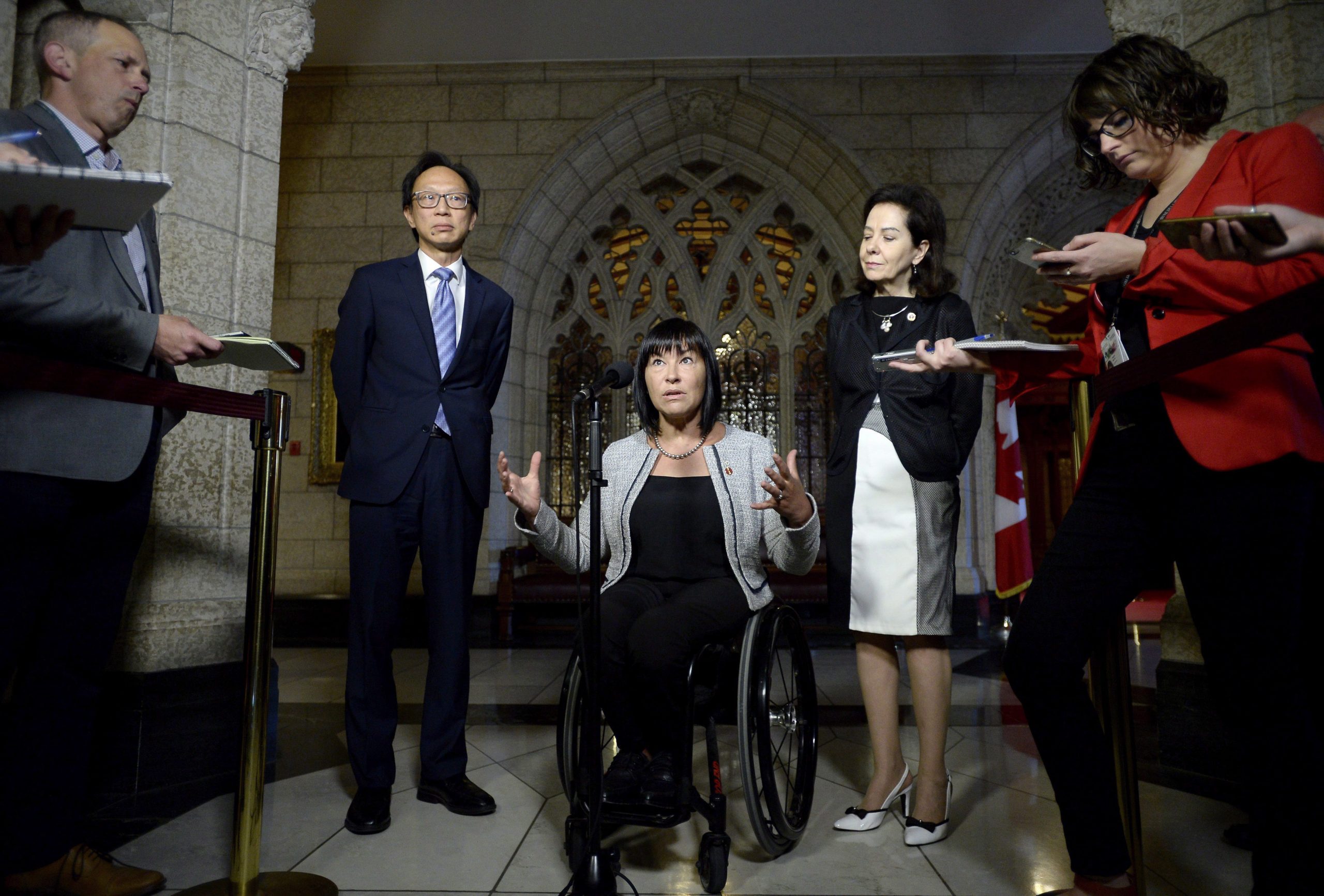Sen. Chantal Petitclerc recounted her own experience with a disability as she sought Tuesday to counter criticism of a bill to expand access to medical assistance in dying.
Bill C-7 has been widely condemned by disability rights advocates who contend the legislation sends the message that life with a disability is a fate worse than death.
They also argue that persons with disabilities, particularly Black, Indigenous and racialized individuals, will be pressured, directly or indirectly, to end their lives prematurely due to societal attitudes, poverty and the lack of support services.
But Petitclerc, a former Paralympian who is sponsoring the bill in the Senate, used her own experience to argue that the bill strikes a balance between protecting the vulnerable and respecting the autonomy of individuals to seek medical help to end intolerable suffering.
She lost the use of her legs at the age of 13 when a barn door fell on her. At the time, she said her mother was recently divorced, working a low-wage job and caring for three young children.
Her mother had to “carry me up and down to the second floor of our apartment building because we could not afford to move,” Petitclerc, a member of the Independent Senators Group, said as she kicked off final debate on the bill.
“So, I may be privileged to be here in the Senate of Canada but I never forget where I come from and I know exactly what it is to be in a situation of extreme vulnerability.”
At the same time, Petitclerc said the bill has evoked in her a strong memory of the excruciating pain she endured in the weeks following her accident as nurses regularly moved her from side to side in her hospital bed to prevent pressure sores.
If she was ever in a position where she was in “pain that unbearable but that would be irremediable, I too would fight for the right” to seek medical help to die, Petitclerc said.
Bill C-7 would expand access to assisted dying to intolerably suffering individuals who are not near the natural end of their lives, bringing the law into compliance with a 2019 Quebec Superior Court ruling.
Petitclerc said critics have “implied that access would be easy or unmonitored” and sought to dispel that notion.
“That simply is not the case,” she said.
She pointed out that an individual must be a competent adult with a grievous and irremediable medical condition, in an advanced state of irreversible decline that causes intolerable, enduring suffering that can’t be relieved by treatment acceptable to the patient.
For people who are not approaching the natural end of their lives, Petitclerc said the bill would impose additional safeguards.
Two medical practitioners would have to agree that the person meets the criteria for an assisted death and had not been pressured in any way. The assessment period would have to last a minimum of 90 days, during which the patient would have to be informed of all alternative means of relieving their suffering, including counselling, community services and palliative care, and be offered consultations with professionals who provide those services.
“I believe it is important that we keep all of these steps in mind and that we acknowledge how thorough, strict and safe this process is,” Petitclerc said.
However, Sen. Kim Pate, another member of the Independent Senators Group, said she can’t ignore the reality of people who’ve experienced “ableist, racist, sexist” and other discriminatory treatment in the health care system or those who’ve been institutionalized and marginalized due to poverty and a lack of support services.
She suggested the bill respects the autonomy of “white, wealthy and non-disabled” people at the expense of the lives of more vulnerable people.
“Bill C-7 stands to expand rights for some at the expense of increasing inequality for others,” Pate said, urging senators to question their “own ableist fears and biases.”
Sen. Jim Munson, a member of the Progressive Senate Group, said he has spent his Senate career championing the rights of disabled Canadians. But while he agreed the government must do more to improve services for people with disabilities, Munson said he can’t ignore the rights of people like Nicole Gladu and Jean Truchon.
Gladu and Truchon, two Quebecers with disabilities, challenged the law’s prohibition on assisted dying for people who are not already approaching the natural end of life. Justice Christine Baudouin’s 2019 ruling that the restriction violated the pair’s constitutional rights was the trigger for Bill C-7.
Senators have already passed five amendments to the bill, two of which would expand access to assisted dying even more than the government proposed to do.
One amendment would impose an 18-month time limit on the legislation’s proposed blanket ban on assisted dying for people suffering solely from mental illnesses. Another would allow people who fear being diagnosed with dementia or other competence-eroding conditions, to make advance requests for assisted dying.
Conservative Sen. Denise Batters was opposed to the original bill but she said the Senate’s amendments “blow the bill wide open.”
“I’m afraid you’ve put in motion a runaway train and the consequences will be dire,” she said.
Batters predicted the bill will be struck down for violating the rights of people with disabilities, whom she said are “screaming to be heard that they don’t want this so-called benefit.”
“What they want from government is not fast-track to death but rather the necessary financial and other supports that give them the option to live a dignified life.”
By contrast, fellow Conservative Sen. Claude Carignan said the amendments are an improvement. But he still thinks the bill is unconstitutional since it sets up unequal access to assisted dying: a relaxed set of eligibility rules for people who are near death and a more stringent set of rules for those who are not.
One of the roles of the Senate is to ensure legislation is constitutional, Carignan argued, “so logically, if we are certain that a bill is unconstitutional we should either amend it or reject it. That is our duty.”
Several senators urged the government to accept the Senate’s amendments. They noted that the government did not listen to the upper house in 2016 when the Senate urged it to drop the eligibility requirement that a person’s natural death must be reasonably foreseeable – the provision that has since been struck down as unconstitutional.
Sen. Rosemary Moodie predicted that some of the Senate amendments are likely to be rejected by the government again this time. Senators will then have to decide, she noted, whether to defer to the will of the elected House of Commons or dig in their heels.
Senators will wrap up debate on the bill Wednesday before putting the amended version to a final vote later in the day.
The government wants the bill passed by Feb. 26 to meet a thrice-extended, court-imposed deadline.
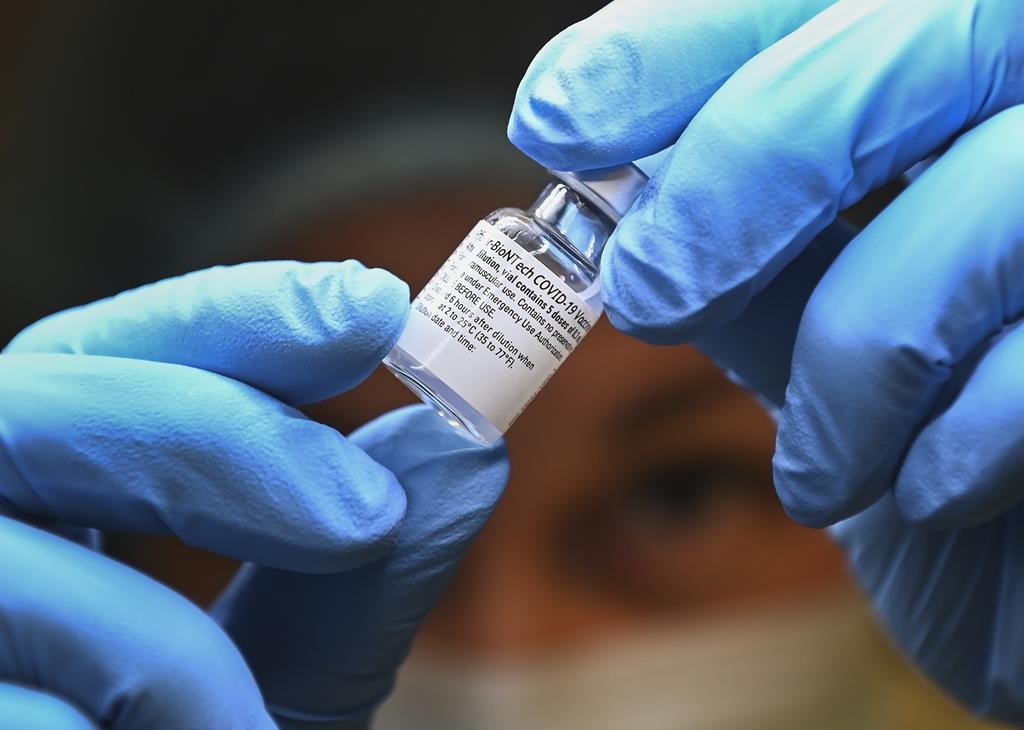
The federal government has confirmed Pfizer COVID-19 vaccine shipments have been delayed by 24 to 36 hours due to the snowstorms that have disrupted much of Canada and the U.S.
The shipment was expected to arrive on Tuesday, but they will now be arriving tomorrow or Thursday.
The Pfizer-BioNTech doses are shipped to Canada from Belgium through the U.S. and will be delivered directly to the site they are administered due to cold storage requirements.
Deliveries of the vaccine had been slowed down over the last month while a plant in Belgium was expanded.
However, the Trudeau Liberals say the deliveries will be ramping up over the next few weeks and Pfizer is scheduled to ship 3.1 million doses to Canada between this week and March 31.
“We are on schedule to receive our single largest Pfizer vaccine shipment to date and next week we are expecting an even larger shipment again,” Trudeau said at a news conference on Tuesday morning.
Canada is still expected to receive the same amount of doses despite the poor weather delays.
Snow, ice and bitter cold also forced authorities to halt vaccinations from Pennsylvania to Illinois and from Tennessee to Missouri in the United States.
The Biden administration said the weather was expected to disrupt shipments from a FedEx facility in Memphis and a UPS installation in Louisville, Kentucky. Both serve as vaccine shipping hubs for a number of states.
With files from The Canadian Press
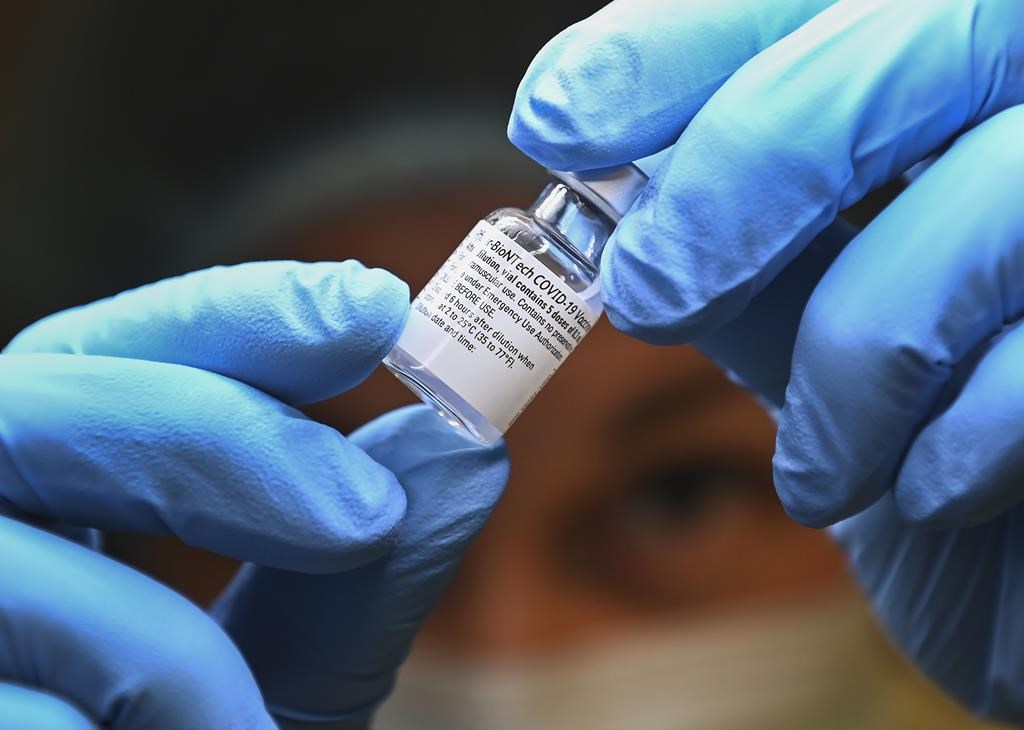
OTTAWA — Canada’s sluggish COVID-19 vaccination efforts are expected to get a big boost starting this week as the federal government prepares for a ramp up in the delivery of shots from Pfizer-BioNTech following a month-long lull.
The Public Health Agency of Canada has stated on its website that it expects more than 335,000 doses of the Pfizer-BioNTech vaccine to be delivered this week, though the company says the figure will be closer to 400,000.
That is because the health agency’s number is based on five doses per vial, even though the federal government recently agreed with Pfizer’s request to have six doses administered per vial.
Either way, the expected delivery will represent the single largest shipment to Canada since the start of the pandemic as Pfizer continues scaling up production after a month-long slowdown while it expanded a plant in Belgium.
Canada’s vaccination efforts slowed to a crawl during that time, taking delivery of 339,000 doses of the Pfizer-BioNTech vaccine between Jan. 18 and last week rather than the promised 1.15 million.
Pfizer is expected to deliver an even larger shipment next week, and has said it will make good on its promise to deliver a total of 4 million doses by the end of March.
The new deliveries will be welcomed by provinces and territories, which have administered the vast majority of the vaccines that they have received.
They will also likely ease some of the pressure on the federal Liberal government, which has been accused of mismanaging what amounts to the largest mass-vaccination effort in Canadian history.
Prime Minister Justin Trudeau last week acknowledged the struggle with deliveries, but said things will get better in the weeks ahead, and even better than that in April, when Canada is expecting as many as one million doses a week.
“We’re approaching something we’re calling the big lift,” he said Thursday in a virtual roundtable with nurses and doctors from around Canada.
Yet the problems aren’t entirely over. Moderna — the other company whose vaccine has been approved for use in Canada so far — has confirmed its next shipment on Feb. 22 will be only 168,000 doses, two-thirds of what had been promised.
Moderna, which delivers once every three weeks, shipped 180,000 doses last week — 80 per cent of the promised amount.
In addition, Pfizer’s deliveries will only meet the promised number of doses if medical professionals can adjust to extracting six doses instead of five from every vial.
Getting that sixth dose requires the use of a low dead-volume syringe, which traps less vaccine in the needle and syringe after an injection.
Canada has now ordered 72 million of those syringes, and two million were delivered last week.
Maj.-Gen. Dany Fortin, the military commander overseeing Canada’s vaccine distribution, has said those are being shipped to the provinces to be ready for Monday, though no provinces reported receiving any as of Thursday.
Provincial governments are also concerned about how easy it will be to get that sixth dose, even with the special syringes.
To date, Canada has received about 928,000 doses from Pfizer and 515,000 from Moderna.
This report by The Canadian Press was first published Feb. 15, 2021.
Lee Berthiaume, The Canadian Press

Toronto Raptors president Masai Ujiri is speaking out after a U.S. sheriff deputy dropped a lawsuit against him following a shoving match at the 2019 NBA Finals.
“I am so lucky to have my beautiful, loving, supportive family,” Ujiri said in a statement on Monday. “I’m grateful to the Raptors players, staff and coaches for having my back…You all stood with me.”
Deputy Alan Strickland alleged in a lawsuit filed one year ago that he suffered injuries “which caused and continue to cause great mental, physical, emotional and psychological pain and suffering” after a shoving match with Ujiri.
The incident occurred June 13, after the Raptors won the deciding Game 6 of the 2019 NBA Finals against the Golden State Warriors at Oakland’s Oracle Arena. Ujiri went onto the court to join his celebrating team, when Strickland stopped him because the Raptors executive didn’t provide the proper on-court credential, leading to a shoving match that was partially captured on video.
Several bystanders intervened and Ujiri got onto the court without displaying any credentials.
Bodycam footage of the incident that was released appears to support the executive’s claim that Strickland shoved him twice despite Ujiri flashing what looks to be a card attached to his body.
WATCH VIDEO: https://toronto.citynews.ca/2021/02/15/raptors-president-masai-ujiri-speaks-out-after-u-s-sheriff-deputy-drops-lawsuit/
Ujiri says he has decided his fight is no longer a legal one.
“Now the challenge is this: What can we do to stop another man or woman from finding themselves in front of a judge or behind bars because they committed no crime other than being Black?”
“That is the work that each one of us must commit to, every day,” he added.
The Toronto Raptors also shared a video of Ujiri dated August 2020 on their Instagram page, in which he stated “We have to make it better. We have to fight, and we have to stand up, and we have to speak.” He ended by saying “it comes down to human decency.”
https://www.instagram.com/raptors/?utm_source=ig_embed
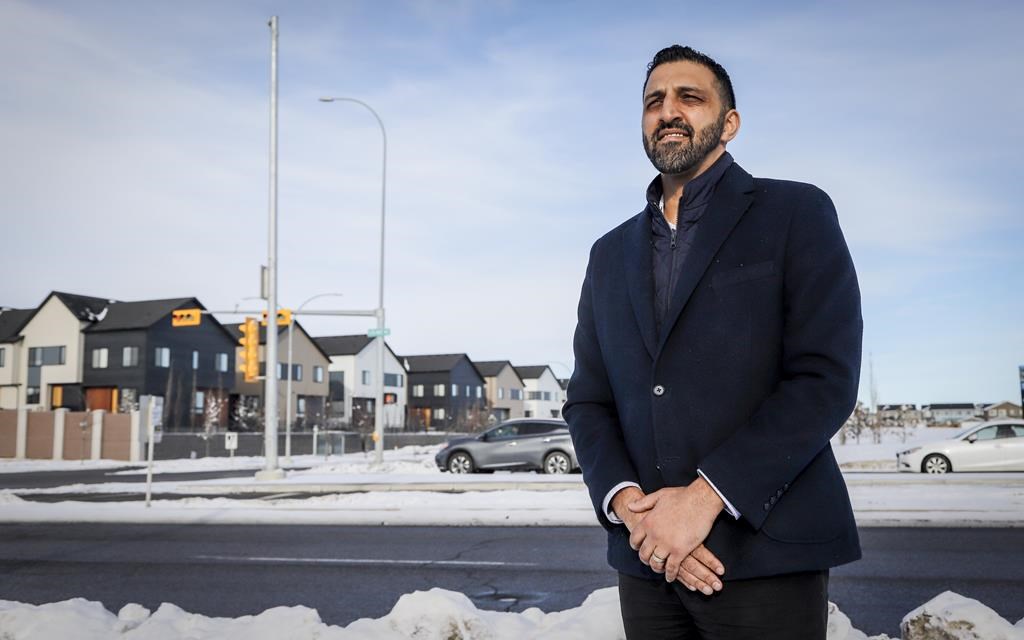
OTTAWA — Kelly Ernst recalls standing on sidewalks, waving to needy families in Calgary’s northeast as they opened their doors to pick up food hampers.
Ernst, vice-president for vulnerable populations at Calgary’s Centre for Newcomers, said the memory speaks to how COVID-19 hurt the community, socially and economically.
Ernst said the Skyview Ranch neighbourhood is one of the most diverse in the country, with a high proportion of visible minorities and newcomers. Residents are often employed in precarious retail jobs or in warehouses, Ernst said. Others work at the city’s airport or in the municipal transit system, both of which were also affected by the pandemic.
“Some of the first people to be laid off during the downturn were people in these precarious jobs,” Ernst said, adding many were left looking for “some way to get through this whole thing.”
Almost seven in every 10 residents over age 15 in Skyview Ranch, received the Canada Emergency Response Benefit in the initial month that the pandemic aid was available, one of the highest concentrations among over 1,600 neighbourhoods The Canadian Press analyzed.
Federal data, obtained through the Access to Information Act, provides the most detailed picture yet of where billions of dollars in emergency aid went last year.
The data is broken down by the first three characters of postal codes, known as “forward sortation areas,” to determine the number of active recipients at any time anywhere in the country.
The Canadian Press used population counts from the 2016 census to calculate what percentage of the population over age 15 in each forward sortation area received the CERB in any four-week pay period.
Some forward sortation areas in the data from Employment and Social Development Canada were created after the 2016 census and weren’t included in the analysis.
Over its lifespan between late March and October of last year, the CERB paid out nearly $82 billion to 8.9 million people whose incomes crashed because they saw their hours slashed or lost their jobs entirely.
Some three million people lost their jobs in March and April as non-essential businesses were ordered closed, and 2.5 million more worked less than half their usual hours.
The data from Employment and Social Development Canada show that 6.5 million people received the $500-a-week CERB during the first four weeks it was available, or more than one in five Canadians over age 15.
What emerges from that initial wave is a largely rural-urban split, with higher proportions of populations relying on the CERB in cities compared to rural parts of the country.
Neighbourhoods in Brampton, Ont., on Toronto’s northwest edge, had the largest volume of CERB recipients with postal-code areas averaging over 15,160 recipients per four-week pay period.
CERB usage also appears higher in urban areas that had higher COVID-19 case counts, which was and remains the case in Calgary’s northeast.
“As cities relied more on accommodations, tourism and food as drivers of economic growth, the more they would have been sideswiped by the pandemic, and larger centres have a higher concentration of jobs in these areas,” said David Macdonald, senior economist at the Canadian Centre for Policy Alternatives, who has studied the CERB.
“More rural areas of the country and certain cities that have a higher reliance on, say, natural resources wouldn’t have been hit as hard.”
In Skyview Ranch, census data says 12 per cent lived below the poverty line in 2016, and about three in 10 owners and four in 10 renters faced a housing affordability crunch, meaning they spent 30 per cent or more of their incomes on shelter.
Many live in multi-generational households, which the local city councillor said caused additional concerns about students and working adults spreading the virus to grandparents.
“These are real worries and challenges that members of my community have been facing throughout a pandemic,” said Coun. George Chahal.
“The CERB program and the additional support to small businesses was a huge relief for the fear with many folks in my ward.”
The CERB program paid out $500 per week for people whose incomes had fallen to nothing as a result of the pandemic. The federal Liberals amended the program in April to set a monthly income threshold of $1,000.
At the outset, there were 6,520 residents of Skyview Ranch on the CERB, about 69.4 per cent of the population 15 and up.
Then things improved. Businesses reopened and workers were rehired. The decline in the program’s use in Calgary’s northeast mirrored a nationwide drop in recipients overall, even though there were local increases here and there.
In all, there were 4.4 million recipients in the CERB’s second month, the biggest month-to-month change, 3.7 million in the third, and a steady decline to almost 2.3 million recipients by the time the CERB was replaced by a trio of new recovery benefits and a revamped and restarted employment-insurance system.
Over the lifetime of the CERB, the Ontario town of East Gwillimbury had the highest average number of residents accessing the program, at 24 per cent. The town with the lowest percentage was Winkler, Man., at 3.83 per cent.
In Skyview Ranch, the number of recipients in the last month of the CERB stood at 2,440, or about one-quarter of those over age 15.
There is still hardship in Skyview Ranch. The area has seen a spike in COVID-19 cases and incomes have dropped again as restrictions rolled in through December, part of a wider drop in the national labour market.
Chahal said there still is a need in the area for government aid like the federal recovery benefits.
“Maybe not for everybody,” he said, “but there are going to be a lot of folks who are going to be in need of assistance in the upcoming months as we move from this stage of the pandemic (and) into economic recovery.”
This report by The Canadian Press was first published Feb. 15, 2021.
—With files from Lucas Timmons and Meredith Omstead
Jordan Press, The Canadian Press
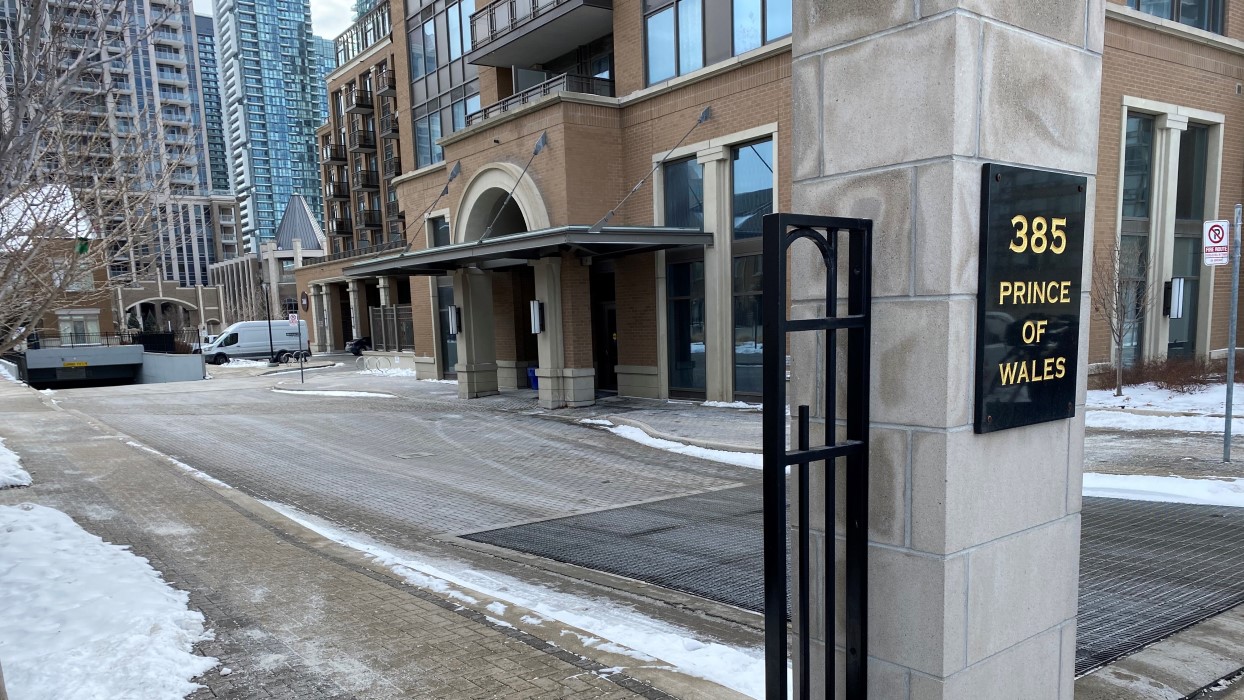
Public health officials are testing all residents of a Mississauga condo building for COVID-19 after five people who live there tested positive for a more contagious variant of the virus.
Peel Public Health says it’s taking the “urgent” step now, while community spread of the B.1.351 variant that first emerged in South Africa is still low.
The agency says it will conduct testing floor-by-floor in the building, which is located on Prince of Wales Drive, in the Confederation Parkway and Rathburn Road West area, on Monday between 11 a.m. and 4 p.m.
Andrew Mitton, who has lived in the building for about three years, said he was a little concerned when he first got the email about the positive cases.
“We got an email yesterday evening, basically notifying us that there was a [COVID-19] variant of concern in the building and that the city would be coming around to do some testing today,” he told CityNews. “That was all that we were told.”
Mitton admitted he didn’t know much about the new variants but he feels relieved that public health came to test so quickly.
“If the variant is concerning the government and health officials as much as it is, then I think it probably is the right thing to do to come in and test everyone in the building and make sure that this isn’t being spread. If one person is positive there’s a likely chance others are.”
When it comes to having the virus in the building he calls home, Mitton said he finds his neighbours and condo staff are taking COVID-19 protocols seriously.
“Our security guards do a tremendous job of keeping things enforced,” he said. “For the most part I think people are pretty diligent about others and keeping others in mind.”
Peel Public Health says residents who were unable to get tested can also attend a testing centre in the community.
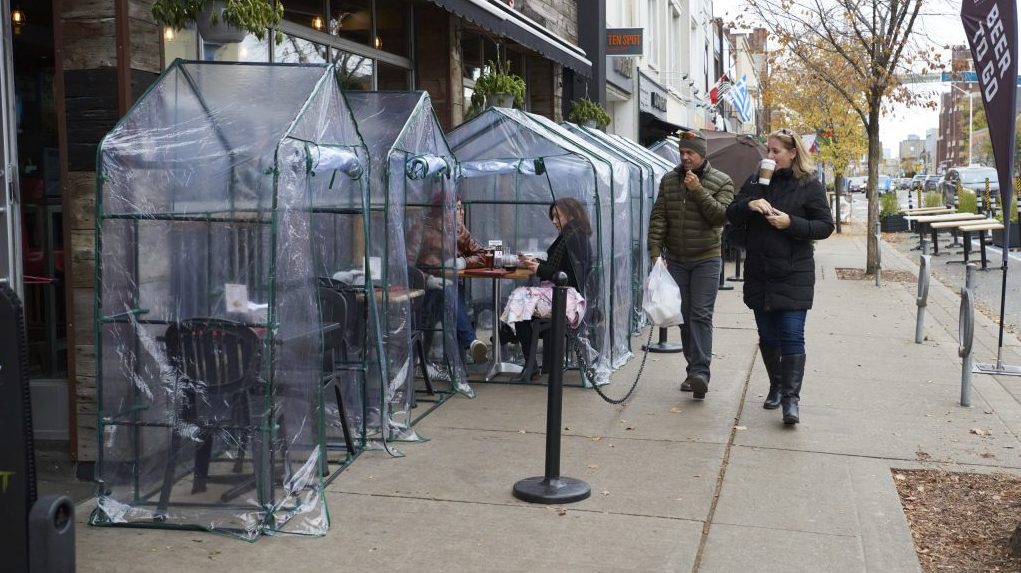
Ontario’s top doctor says the government will announce Friday which categories of its COVID-19 restrictions system some regions will fall into when they begin to reopen next week.
Chief medical officer of health Dr. David Williams has said the decisions will be made based on local virus case rates.
The province began a gradual reopening of its economy Wednesday by lifting the stay-at-home order for three regions with low cases.
The rest of the province, except for three hot spots in the Greater Toronto Area, are set to have the order lifted next week when they transition back to the colour-coded restrictions system.
Toronto, Peel Region and York Region are set to remain under the stay-at-home order until at least Feb. 22.
The government has warned that a sudden spike in cases could delay the reopening of any region in the province.
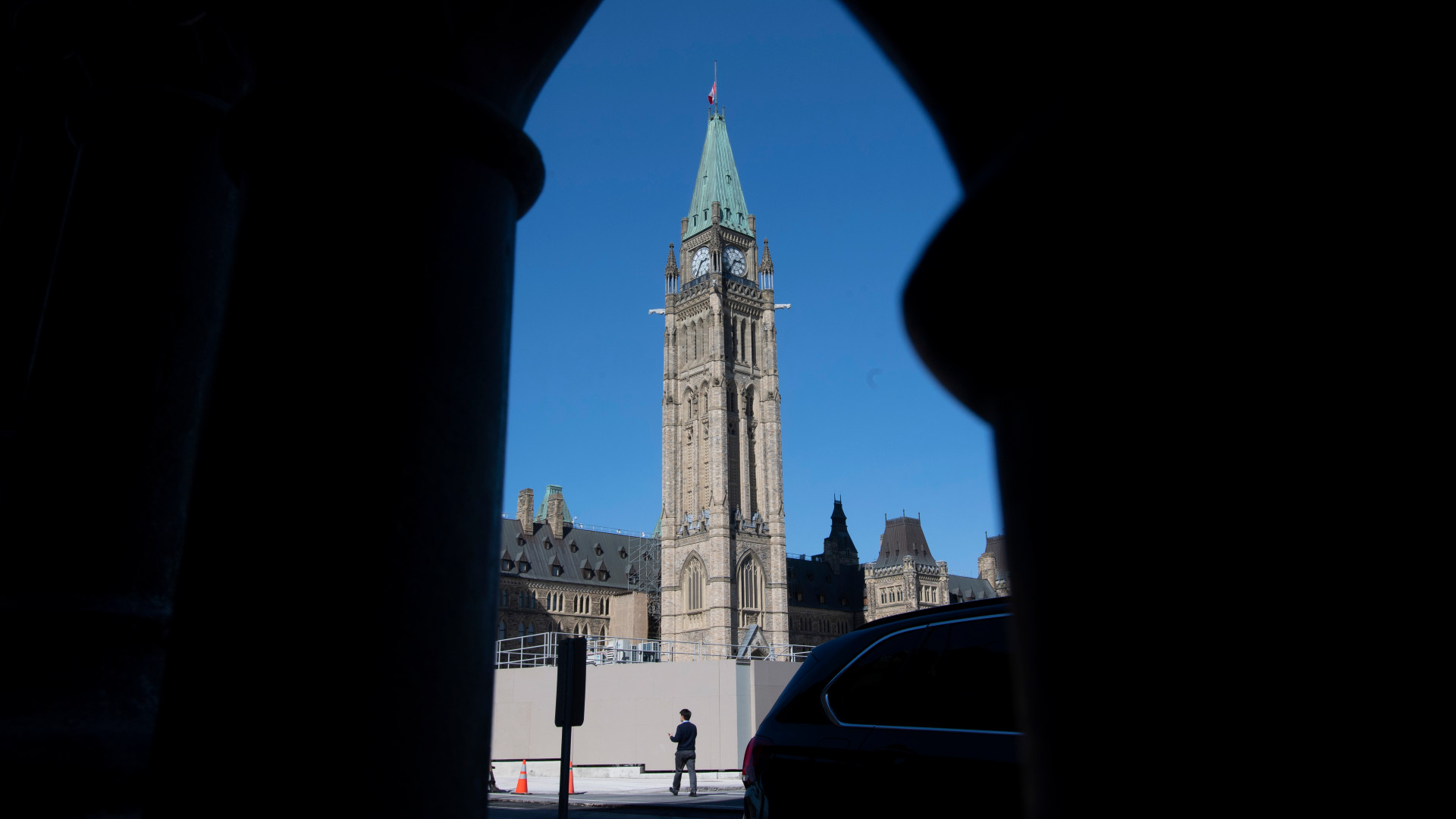
Senators want the federal government to collect race-based data on who requests and receives medical assistance in dying in Canada.
They approved Thursday an amendment to Bill C-7 requiring the government to collect such data.
The bill would expand access to assisted dying to intolerably suffering individuals who are not near the natural end of their lives.
The amendment reflects concern that Black, racialized and Indigenous people with disabilities, already marginalized and facing systemic discrimination in the health system, could be induced to end their lives prematurely due to poverty and lack of support services.
Sen. Mobina Jaffer, a member of the Independent Senators Group who proposed the amendment, noted that no race-based analysis was done when the bill was being drafted.
“One in four people have been left out of the data collection,” she told the Senate.
Her amendment was widely supported and passed on a voice vote with no objections, other than the government’s representative in the Senate, Sen. Marc Gold, saying that he wanted to abstain.
Sen. Kim Pate, another member of the Independent Senators Group, said the amendment won’t ensure that no one opts for an assisted death as a result of unequal access to health care, housing and social and income supports.
But she said it will ensure that “the government must at least provide some answers about who makes use of Bill C-7 and under what circumstances.”
Pate said the government should also be required to provide more information on who accesses assisted dying, including income, whether they are institutionalized and whether they had access to alternative means of relieving their suffering and to social and financial supports.
Senators burned the midnight oil Thursday night as they continued debating and proposing amendments to the bill.
The extended hours were part of the Senate’s determination to wrap up debate and put C-7 to a final vote by next Wednesday.
The schedule is intended to give the government time to meet the thrice-extended court-imposed deadline of Feb. 26 for bringing the law into compliance with a 2019 Quebec Superior Court ruling.
That ruling struck down a provision that allows access to assisted dying only for intolerably suffering people whose natural deaths are reasonably foreseeable.
Earlier this week, senators approved several substantial amendments to the bill, including one that would allow people who fear losing mental capacity to make advance requests for assisted death and another that would impose an 18-month time limit on the bill’s proposed ban on assisted dying for people suffering solely from mental illnesses.
If senators approve an amended bill next week, it will have to go back to the House of Commons to decide whether to accept or reject the changes and then back to the Senate to decide whether to accept the Commons’ verdict.
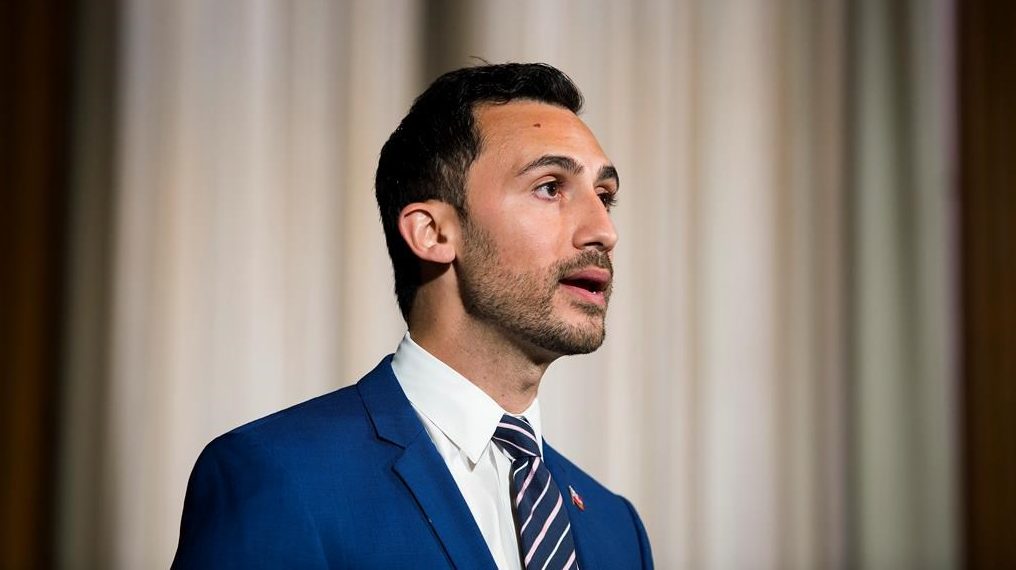
Ontario’s education minister has announced March break will be postponed for all schools across the province until the week of April 12.
Stephen Lecce says they are postponing the break to reduce travel and limit opportunities for congregation as concern for variants increases.
He added the decision was made in consultation with public health officials.
“I recognize this is one more change in a year that has been challenging for so many students and our education staff,” Lecce said Thursday. “But it is one made on the best advice of public health officials to keep them safe and to keep our schools open in this province.”
The province’s largest teachers’ union has called on the government to keep March break in place, saying students, families and teachers need the time off.
Schools across Ontario, except those in three Greater Toronto Area hot spots, have resumed in-person learning after a stretch of online classes.
Students in Toronto, Peel Region and York Region return to physical classrooms on Feb. 16.
Top doctors in Toronto and Peel have warned that rolling back other restrictions as students resume in-person learning amid the spread of new virus variants could kick off a worse wave of infections.
The provincial and the federal governments have been urging residents to limit their travel.
The federal government recently introduced its own policies aimed at preventing travel over the spring break. Four major airlines have halted their flights from Canada to Mexico and the Caribbean until the end of April.
The provincial government has also introduced mandatory COVID-19 testing for all international arrivals to Ontario.
WATCH VIDEO:
https://toronto.citynews.ca/2021/02/11/ontario-march-break-schools/
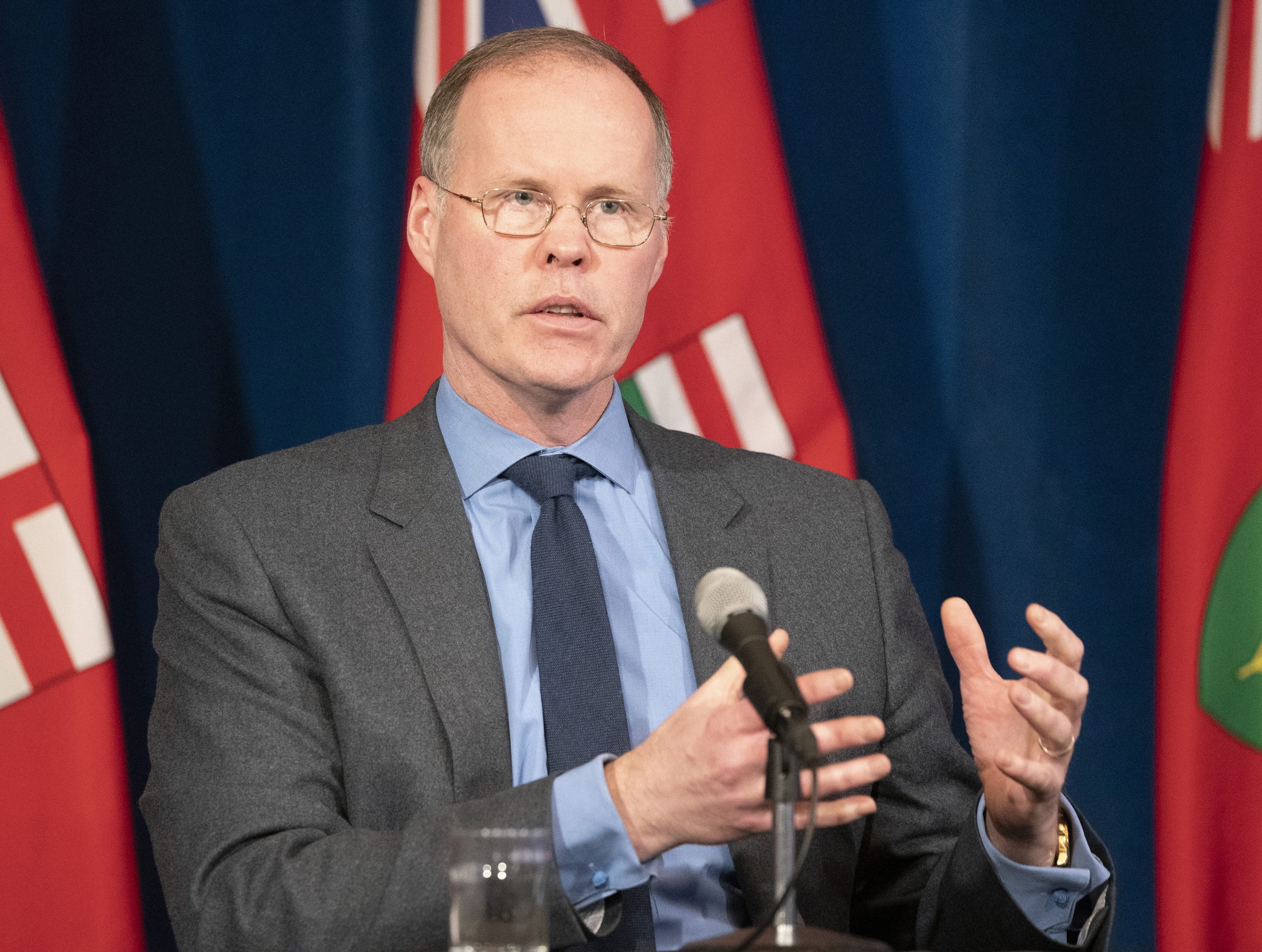
While public health measures have helped curb the cases of COVID-19 and led to a decrease in hospitalizations, variants of the coronavirus are spreading and are expected to increase by the end of the month.
Dr. Adalsteinn Brown, co-chair of the province’s COVID-19 science table, says the latest modelling data shows aggressive vaccination coupled with stay-at-home measures will help the province avoid a third wave and a third lockdown.
Provincial health officials indicate that if public health measures are lifted, cases could rise dramatically depending on the spread of the UK COVID-19 variant, which will soon be the dominant strain in new cases.
Currently, variant strains of the virus account for between five- and 10 per cent of all COVID-19 cases in the province.
“The new variants of concern that spread so much more easily are here and they threaten to undo our progress,” said Brown.
According to the latest provincial data, a total of 239 variants of concern have been recorded to date – 236 of those are the UK variant. The province has also seen cases of the South African variant and recently reported its first case of the Brazilian variant of the virus.
The Ford government’s state of emergency expired on February 9 and the province has begun to ease restrictions to allow businesses to reopen as regions gradually transition back to the colour-coded framework. Stay-at-home orders are expected to remain in effect for Toronto, Peel and York regions until February 22.
Absent any restrictions, the modelling data says Ontario could see almost 2,000 new cases of COVID-19 a day by the end of March with a worst case scenario of almost 18,000 cases a day.
“We are, let me be clear, operating with uncertainty. That is the nature of a new disease with new variants but we need to do as much as we can to reduce that uncertainty. The best bet we can offer from the science this: if we’re able to push the impact of COVID-19 down further by sticking to public health measures and aggressive vaccination we can avoid a third wave and hope for a late spring and summer that is much safer and more open,” said Brown.
The data also reveals that focusing vaccinations on long-term care settings is paying off as the number of daily deaths declines. However, the number of deaths from the second wave is expected to surpass the total number of deaths from the first wave in a matter of days.
While hospitalizations have started to decline, ICU occupancy remains flat. However, an increase in new cases spurred on by the new variants could see ICU numbers climb once again, as early as the second week in March with admissions surpassing 600 by the end of the month.
“In a matter of months, the B.1.1.7. variant went from detection to the dominant strain and as it became the dominant strain cases more than tripled in a month,” Brown said. “At the same time their healthcare system strained with nurses forced to care for four to eight times as many patients as usual and there were daily deaths regularly in excess of 1,000 people. …But there is little room for error in our response to this threat.”









